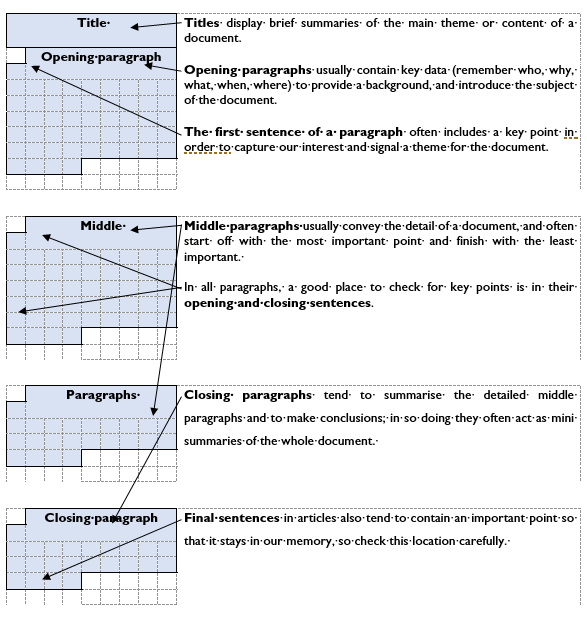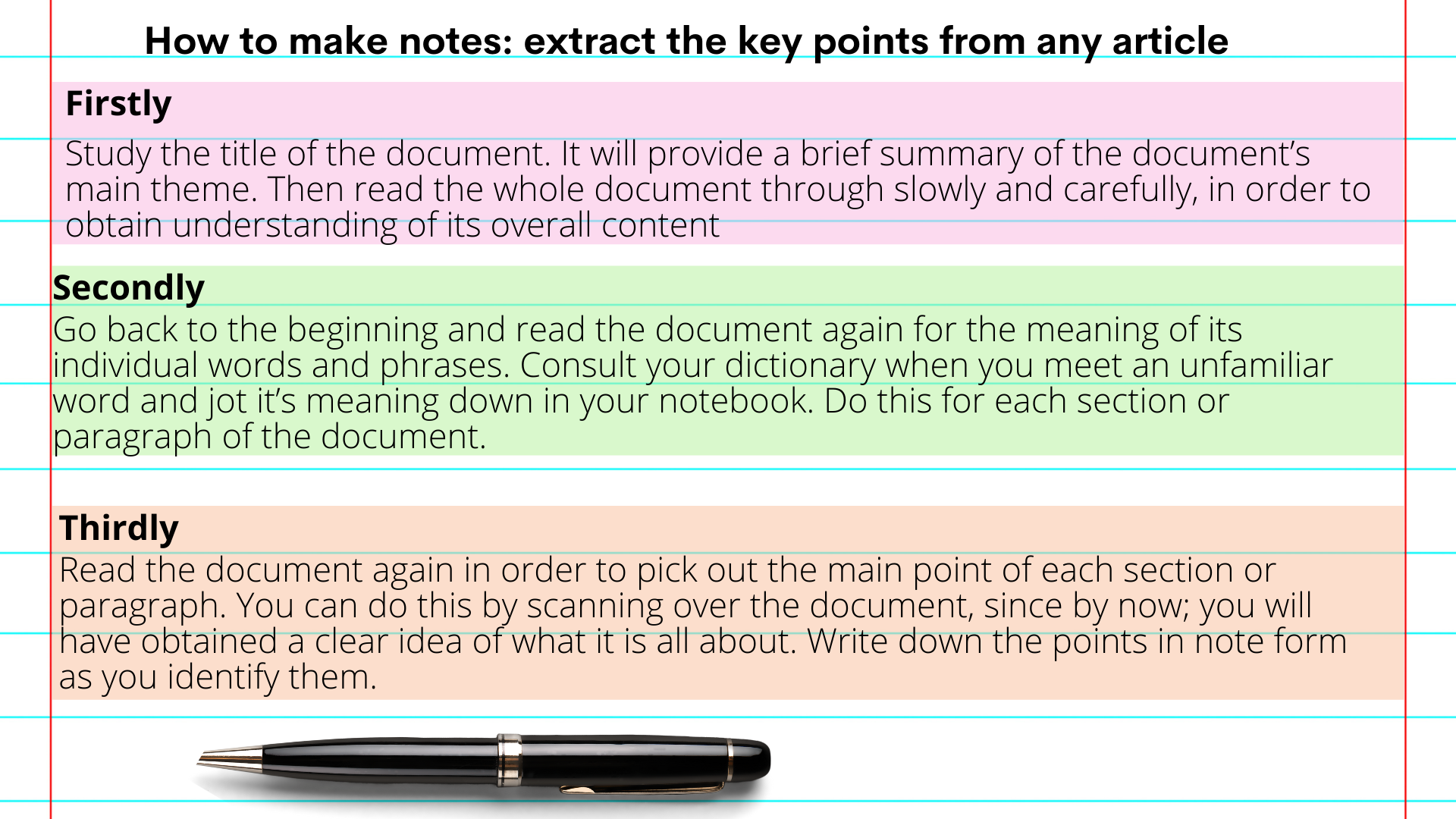Reading a document carefully, so as to understand fully what it is about, is the first of the two main steps needed to make useful notes of a document. The second is, of course, to make the notes themselves.

Making notes of a document is, essentially, a process, which reverses what the document’s author, did when writing it. Most authors go through these three main stages when writing a document:
- Rough ideas
- Structured into an outline series of points
- Written out in prose paragraphs
When a reader wishes to make notes of the same document, he or she needs to retrace the author’s steps, by going back from the final stage three to the outline skeleton stage two. To do so involves the note-maker in stripping away the words, which are needed to express ideas in full sentences until the key, outline points are uncovered.
As we have already discovered, key meaning tends to lie in subjects, finite verbs and their extensions or objects. We also know where to focus an initial search for key data within the paragraphs or sections of any document. Much like the zoom feature in a word-processing package, we now need to zoom into a sentence or passage, which contains, say, two or three key points, in order to see how the process of identifying them using the parts of speech approach actually works: Study this passage carefully, reading it so as to extract its key meaning using the parts of speech approach:
How to Make Notes
In spite of a temptation to leap straight into the task, it pays to follow a careful series of steps in order to extract the key points from any article.

When you have completed this three-stage process of reading a document to extract it’s meaning, you will be in an ideal position to write down a set of its key points.
Analysing the Reading for Key Meaning Task
An analysis of the first paragraph shows how it helps to go first for the subjects, their finite verbs and either objects or extensions:
- It pays to follow ... a series of steps; ... you can extract ... the key points; ... (you) study the title of the document; It provides ... a summary of the main theme; ... read the document through to obtain understanding of its content; ... read the document (again) for the meaning of words and phrases.
- In the same way. The key word clusters of the second paragraph can be extracted: ... consult your dictionary; ... when you meet an unfamiliar word ... jot down its meaning; ... read the document again; ... etc.
- A glance at the following descriptive words (adjectives and adverbs) illustrates how much can be stripped out, without losing the passage’s essential meaning
- careful... firstly and very importantly ... brief ... whole ... slowly and carefully ... overall... Secondly ... individual... in your notebook ... Thirdly ... etc.
Word Clusters to Skim Over
As well as skimming over word clusters, which provide additional, but not essential descriptive information, it helps to leave out of consideration the following kinds of word clusters:
Word clusters used to introduce or to link ideas together, which contain no important point:
- In spite of a temptation to leap straight into the task,
- Firstly, and very importantly
- Secondly, go back to the beginning and
Words or phrases which are repetitions or restatements of points already made:
- Do this for each section or paragraph of the document.
- Of reading a document to extract its meaning,
Words or phrases which are examples or illustrations of a main point: such as a point made in the first sentence
In point of fact, the above worked example is fairly closely written, in that there are not very many word clusters, which are of secondary importance.
How to Make Notes
- It pays to follow - a series of steps - to extract key points - from articles
- Study title of document first - for brief summary of main theme
- Then: read through all document - for understanding of overall content
- Consult dictionary on unfamiliar words - jot down meanings
- Read document again for main points - scan over paragraphs
- Write down identified main points in note form
- Three-stage process - ideal preparation for note-making
Summary of Key Points
How to take effective notes of reading material:
- When reading a document for a purpose, read it three times: firstly, to get a general idea of its main theme and content, secondly to find out what any unfamiliar word or expression means, and thirdly to see how the main points are structured.
- Remember where to look for likely key points: the title, the first and last sentences of the piece, and the first and last sentences of each paragraph.
- Use the parts of speech and grammar functions of word clusters to identify the most important words and ideas in sentences, and disregard the descriptive words (for the most part - but not entirely).
- Make notes of the important word clusters you identify in brief bullet points - not as full as complete sentences but not so abbreviated that even you can’t understand them at a later date!